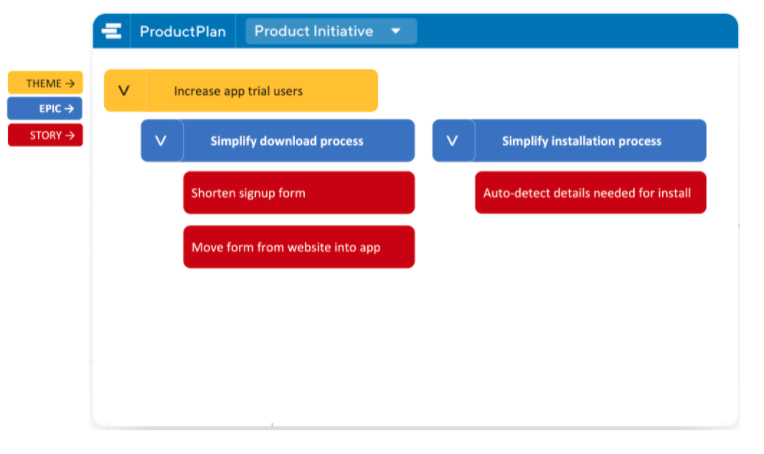What is an Epic?
An epic in product management is a group of related development tasks between high-level strategic themes and actionable user stories.
You can think of an epic in two ways:
1.) The top-down view:
An epic is a body of work that a product team devises as they break down a strategic theme into smaller initiatives. A theme on your product roadmap might contain two or more epics.
2.) The bottom-up view:
An epic is a body of work representing a group of user stories sharing a common strategic goal. Several related stories on the roadmap will often roll up to a single epic.

What is an Example of an Epic in Product Management?
Look at the graphic at the top of this page. It represents a section of a hypothetical software company’s product roadmap. Let’s review the details to see how the epics fit into the team’s strategy, which flows from one central theme.
THEME: Increase the number of people using our free trial
To achieve this goal, the product team has identified two epics. We’ll examine just the first one and the user stories that flow from it.
EPIC: Simplify the trial download process
As you can see, this epic represents a subset of the theme to bring in more trial users. But the work required here, to simplify the trial download process, is more than a development team can complete in a single sprint.
For this reason, the team must further break down this epic into user stories that the developers can complete in one sprint.
USER STORY #1: Shorten the signup form
The product team believes trial usage has been low because the current signup form contains too many questions. It turns off visitors.
Following this user story, the team will cut out all but the necessary lead-collection questions. The form might ask only for the user’s full name and email address.
USER STORY #2: Move the signup form from our site into the app itself.
The product team has identified another challenge in their trial process. When users click the “TRY IT FREE” button, they encounter the signup form right away. They have not yet invested time in starting the download process, so they are more likely to abandon the form.
The team would like to let users make progress accessing the trial version before filling out the form. They can download the app, install it on their computer, and see the product interface on their screen. Then, before they can perform any action with the product, they’ll need to complete the form.
This way, users have already invested time and effort in starting the trial. They can also see that they can start using the app immediately after they’ve finished the form.
Bottom line: A product team develops an epic by breaking down a high-level product theme into more manageable components. Then, they will need to break down each epic into actionable tasks, the user stories.
How to Write an Epic?
There are many ways you can write an epic. But most approaches have a few steps every day. Let’s walk through them.
Step 1: Name the epic.
Before you can start planning the details of the epic, you need to give it a clear, concise title.
On the hypothetical roadmap above, the product team identified two strategic actions to help achieve their theme of increasing trial downloads. For one of those strategies, they named the epic “Simplify download process.”
You want to start your epic writing process with the name because it helps clarify your strategic goals. You will also find it helpful to have a standard way of describing the strategy. It will reduce confusion and miscommunication among your team.
Step 2: Write a narrative explaining the epic.
Next, you will write a short description of what you hope to achieve with the epic. This narrative should contain at least the following:
1. Who: the persona (in this case, the product manager)
2. What: your objective
3. Why: the value behind the objective
Here is a template you can use to fill in the details:
As the [product manager], I want to [simplify the trial download experience] so that [we increase the number of people who complete the trial download process].
Pro tip: You can also include another sentence or two with background information that helps explain why this epic matters.
For example, in our hypothetical, you might include a note about your research, which includes:
- Current abandon rates on your trial download web page
- Data indicating these abandon rates are higher than the industry average
- Data showing that your signup form contains more fields than the industry average
Step 3: Establish the scope for the epic.
You will now want to jot down the scope of work for this epic—in other words, the boundaries. The range of work will help your team to stay on track.
Going back to our hypothetical, “Simplify the download process,” you might want to specify:
- Which trial downloads to focus on
- Which form fields to eliminate (and which to keep)
- Where you wish to relocate the form
Step 4: Define completion for the epic.
As a product manager, your team will need to know when to define completion for the epic. You will also need to write a clear set of acceptance criteria—the high-level list of requirements your team will need to approve. With our hypothetical, this acceptance criteria would include:
- Marketing supports the final form.
- Development can demonstrate the new form is capturing leads.
- Development can show that these leads are feeding into our sales system.
- The development team can confirm that we can track the abandon rate in the app, where we’ve moved the form.
- Development can show that these leads are feeding into our sales system.
- Development can demonstrate the new form is capturing leads.
Step 5: Break the epic down into stories.
At this point, you’ve technically completed and understand how to write an epic in product management. The epic writing phase is complete. You are now ready for the next stage: writing the user stories. But we include this as step 5 to show you how epic creation should flow naturally into writing actionable tasks that your developers can add to their next sprint.




